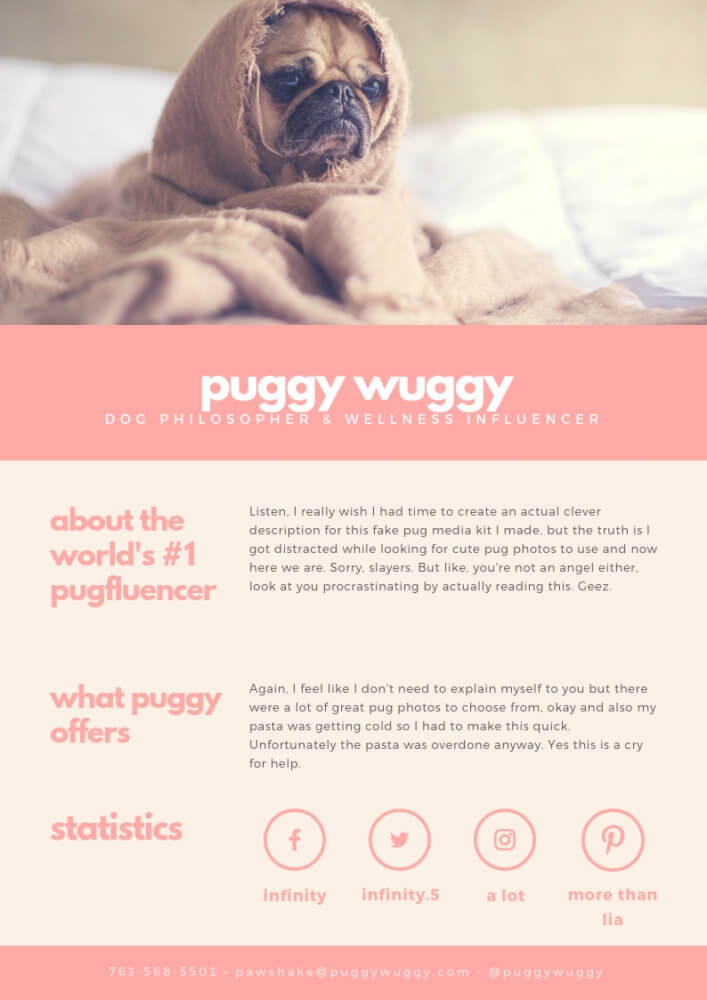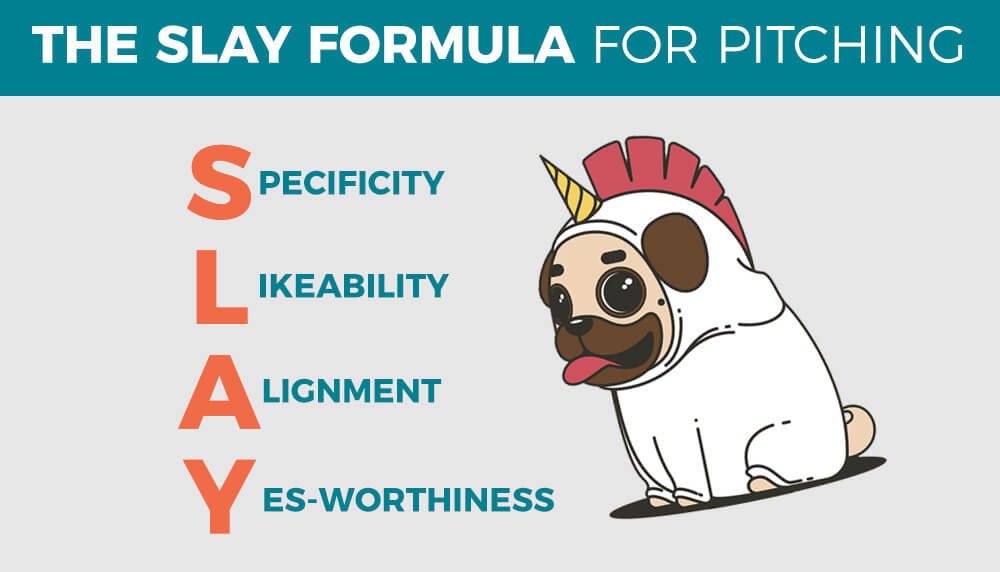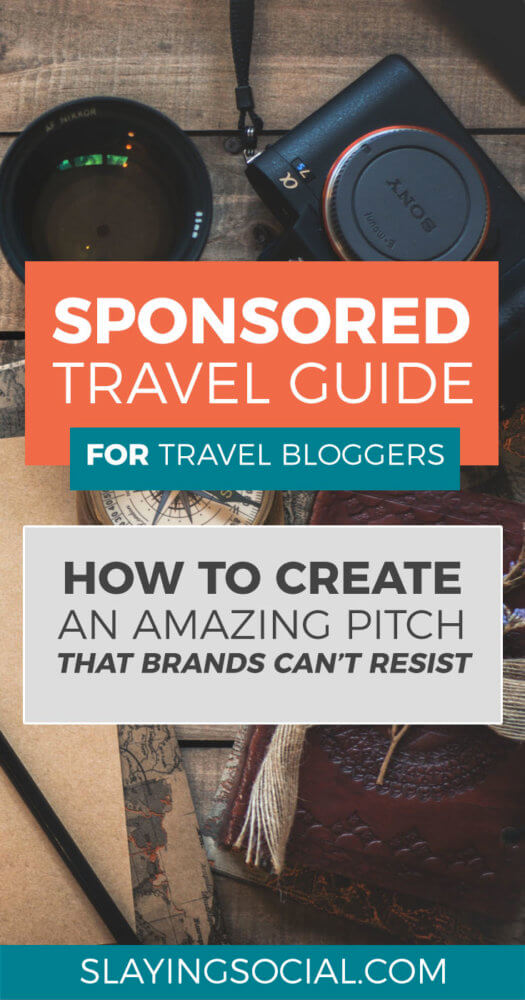*FYI - this post may contain affiliate links, which means we earn a commission at no extra cost to you if you purchase from them. Also, as an Amazon Associate I earn from qualifying purchases. Check out our Privacy Policy and Disclosure. for more info.
In the travel blogging world, there are few topics more shrouded in mystery than pitching for brand collaborations.
Well, apart from how we actually afford to survive and stuff. But we already covered that last week 😉
And if you think about it, the mystery around pitching is totally understandable.
After all, from an outsider’s perspective, travel bloggers are no more than little vacation nymphs, scouring candid glitter across the globe, travelling with the wind to luxurious resorts, scenic mountain lodges and ooh-worthy palace-hotels that come with butlers named Jerome.
Not pictured however: 15 hours in front of the computer each day, wearing pyjamas as a uniform, crying a lot unexpectedly.
I hate to be the bearer of bad news, but unfortunately, it’s true.
Travel blogging actually does involve work.
And pitching for brand collaborations?
That’s on a whole other level. It’s more than just work – it’s an art, something to be honed and perfected over time (much like avoiding eye contact on public transport, or not saying ‘you too’ when the server goes ‘enjoy your meal’).
But HOW do you perfect this art? How do you dip your toes into the wild world of brand collaborations and sponsored travel?
Well, that’s why we’re here today.
That’s right, slayers! We have another gargantuan novel for today’s instalment of Blogtoberfest, AKA “Christina and Lia have a lot of thoughts and feelings ”.
Today’s topic is one we hear requests for veryyy often: how to pitch as a travel blogger. And while it’ll be another long one, I promise it’ll be packed with unique insights accumulated over years of trial and error.
My goal, by the end of this post, is to make you want to gouge your eyes out give you a solid idea of what it takes to form an excellent pitch.
So who’s ready to CRUSHHHH it?!?!

First: Why is Pitching for Brand Collaborations Different These Days?
If you’ve spent any amount of time in the travel blogging world, odds are you’ve already read some tips and advice on how to pitch for brand collaborations.
Let me rock your world by now saying that many of these guides are outdated.
*drops burrito in horror*
Below are some reasons why the world of pitching for travel sponsorship has changed, and why your approach to pitching needs to change too.
1. Oversaturation
Everyone and their weird aunt has a blog these days.
Literally, even most dogs have their own Instagram.
And in a world where a blog seems just as common for travellers as passports, brands are getting inundated with pitches more than ever, both from seasoned, professional bloggers (like you, I hope!) and newbies who started their Instagram a hot 5 minutes ago.
This has created a very tough climate to pitch in, because not only are you competing with a huge mosh pit of Wanderlust Wandas and Vagabond Vikrams, you are fighting to prove the worth of travel influencers in a field that’s growing increasingly wary of people like us.
This is why professionalizing your pitches and operating like a business is more important than ever, specifically to combat…
2. Wariness
In recent months, several blogging scandals have opened up the blogging and pitching world to nailbiting scrutiny.
I mean, hands up if you watched with horror (and mild Schadenfreude) as the Internet rallied against Elle Darby’s pitch gone wrong a few months back.
What would’ve once been dismissed as just another bad pitch suddenly became fodder for death threats and unprecedented blogger-hate.
I wanted to cradle in fetal position forever, and I wasn’t even involved.
But that’s not the end of it.
Mainstream media has published several articles denouncing “influencers” who ask for “free stuff”, like here and here.
Whereas once upon a time, many businesses would have seen a blogging pitch as a new, novel opportunity, today they see it as “ugh, another blogger wanting free crap”.
This is a big hurdle to get past if you’re trying to establish a working relationship.
Added to this is the fact that many influencers apparently beg for comp’d goods then run off without providing any deliverables, which certainly does not help our case.
But… there is some light in this very sad, depressing tunnel I’ve just carved for us.
Pitching can still work – you just need to learn how to professionalize the way you pitch and position yourself as an irresistible partner for brand collaborations.
That’s what we’ll be tackling next!

A New Way to Look at Pitching for Travel Sponsorship
Throughout this month’s Blogtoberfest series, our goal is to wrestle you into the mindset that your platform (whether that’s a blog, Instagram, or YouTube Channel), is a BUSINESS.
And as a business, the way you pitch needs to move beyond just saying “hi, can I stay at your hotel for this next moon cycle in exchange for 1.5 Instagram posts of my cat Arthur?”
Remember:
Pitching is not begging.
Pitching is not sending ten million of the same email, to see whoever bites.
Pitching is YOU owning what you can offer to brands, and positioning yourself as a valuable resource to help them solve a problem.
The sooner you realize this, the sooner you can pitch with confidence, find brands that align with you, and yes, the sooner you can start charging your worth and move beyond “freebie” territory (more on this later).
Considerations to Make Before You Pitch for Brand Collaborations
Okay, so before you can pitch like a boss azz professional, there is some foundational groundwork that we need to get through.
If you’re reading this (with a mouth full of wine and popcorn, we hope), odds are you are getting to the point where you feel comfortable pitching for brand collaborations, or it’s something you aspire to do someday.
Now here’s the thing: we are huge advocates for the fair compensation of bloggers.
BUT, when you’re first starting out, you need to get some successful exchange-based travel sponsorship under your belt before you can confidently pitch for paid brand collaborations.
That’s why the tips below will mostly relate to these in-kind brand collaborations, like complimentary hotel stays, experiences, etc.
It goes without saying, pitching for PAID trips is a much more advanced strategy altogether, and we’ll be addressing it briefly at the end of this post.
But, know that before that’s possible, you should have some partnerships under your belt to prove your worth and ROI.
And so, let’s get down to it. Before you even start to type out those golden pitches, here are some considerations you need to make…

CONSIDERATION #1: Does this brand even work with influencers?
Fact: your pitch will be much better received if the brand actively works with bloggers and influencers.
Think the difference between pitching a sleek modern hotel with a social media department vs. pitching a random guesthouse in the Alps, run by an 80 year old German man named Ludwig.
Ludwig (probably) does not care about your page views. Ludwig cares only for his cat, Jürgen.
Now, this isn’t to say you can’t cold pitch a brand that has never worked with bloggers before, but if you want to maximize your chances of success, you should do your homework and see whether or not your desired brand works with influencers.
It’s just an easy way to narrow down your prospects.
So how can you tell if a brand is open to influencer partnerships? Short of lurking in the bushes outside their office (which probably wouldn’t work anyway), here are some tricks:
Creep their Media or Press page
Most bigger hotels or companies will have a Media page or Press page. Often this page will have things like press clippings that talk about their business, or information useful for media (e.g. contacts, photos, press releases, etc.)
If at any point on this page, you see bloggers explicitly mentioned, this is a great sign!
They might have some links to articles written by bloggers before, or perhaps they just state “for inquiries from bloggers and social media influencers, contact [email protected]”.
Take these as big thumbs up to pursue your pitch.
Search up the business + “opinions are my own” on Google
This is the oldest trick in the travel sponsorship book.
By Googling this phrase, you’ll be digging up any past collaborations that the business might have done with a blogger or influencer.
Truthfully, this doesn’t work as well as it once did because people are switching up their disclosures a lot more now, probably to avoid people creeping their past collaborations. Heh.
BUT you can always try variations such as business + “hosted”, “thank you to…”, etc. Basically any phrases you think might be used in a disclosure.
The businesses you find through this method will be familiar with bloggers and influencers, which is a good sign.
Try looking for a branded “partner” hashtag
If you want to go into ultra-detective mode, a lot of brands have begun asking their influencers to tag posts with #_____partner in addition to #Ad, so imagine like, if you got sponsored by Hilton, you would use #HiltonPartner.
Because of this, a unique way to creep whether or not the brand works with influencers is to look up #INSERTBRANDHEREPartner to see if that’s a thing.
If you find posts, then clearly they have dabbled in influencer marketing.
Alright, after you’ve discovered the brands that do work with influencers, then it’s onto consideration two.
How it feels when you find the perfect brand to pitch. via GIPHY
CONSIDERATION #2: Do you understand the product & value you have to offer?
If you’re anything like beginner-me, that question has probably brought you to tears/fetal position.
*hands out tissues like Oprah*
I know it’s tough, but before you can pitch, you need to have a good grasp on your blog, your audience and the value you have to offer brands.
After all, this isn’t just a mad grab for free things, remember that pitching is YOU helping build a mutually beneficial relationship.
That’s why in order to craft a yes-worthy pitch, you need to first figure out what it is you have to offer on your end of brand collaborations. This can be accomplished by asking yourself a few key questions, such as:
- Who is my audience? What age, gender, geographical area, income level, interests, etc.?
- What is my niche?
- What is unique about my platform?
- What proof do I have that I do in fact have influence or the trust of my audience?
Being able to answer these questions is key, especially that last one.
See, one of the biggest questions that people have as beginner pitchers (which sounds like a baseball thing, but isn’t) is “how big do I need to be before I can start pitching?”.
Honestly though, this is the wrong question to ask.
In a world where numbers can be faked and where I could literally just go out and buy 100k followers for 5 bucks right now, the question shouldn’t be about the SIZE of your audience… rather, what brands want to know is your actual impact and influence.
This is why I advocate for a trust and value-based approach to pitching, rather than solely numbers. I’ll explain this more in detail later. But first, you must also ask yourself…
CONSIDERATION #3: What are the needs of the brand?
So, at this point, you probably have a clear idea of what YOU want from your brand collaborations, whether that’s a sponsored tour, hotel stay, meal or whatever, but your pitch will be incredibly weak if you fail to mention what’s in it for them.
So, what can you provide? To answer this question, you must first reflect on the needs of the brand. Do I sound like a couple’s counsellor or what?
Anyways, here are some potential things a brand might want out of a collaboration:
- Brand awareness
- Conversions (e.g. bookings, sales, etc.)
- New content to use on their websites/social media
- Buzz around a new initiative
Now comes the more complicated bit: how can you figure out what they need?
Of course you could ask them, but if you really want to blow them away with your pitch, you should include some stalkery research you’ve already conducted.
This will set your pitch apart.
Showing you’ve done even a smidge of research will elevate you above the countless cookie cutter emails that invade their inboxes daily.
A bespoke pitch with actual research and detective work is what makes you a pitching professional, and not “just another blogger”.
Being professional, even when you’re a total beginner, is something that will pay dividends in the long run.
*puts on giant glasses* Here’s a quick storytime to illustrate my point!
The year was 2015, and I was in the midst of what I consider to be my “awkward ugly phase” of travel blogging.
One of the first pitches I ever sent was for two passes at a very expensive mountain-top attraction.
The pitch was detailed, alluded to recent news at the attraction from their website, and if I dare say, pretty professionally written.
The woman replied back saying they never accepted blogger requests, but liked my professionalism, so said yes, and comped my passes ($150USD value).
Fast forward three years, I was rocking a blazer, sweating trails across my first big travel trade fair.
I happened to run into this same woman, who remembered me and had been following my travels this entire time.
She then proceeded to twirl me around, introducing me to all her colleagues at her country’s pavilion, which spun into further collaborations and valuable connections.
We now like each other’s pics on Instagram all the time. It’s pretty cute.
Anyways, the moral of that ‘drunk uncle-esque’ story is that professionalism sets you apart. Don’t forget it!
… And it starts with thoroughly researching the needs of your dream brand. SO, here’s how to stalk what a brand might be needing:
- Scour their site for press releases and news
- Stalk their social media for any news, updates, etc.
- Depending on the time of year, check if they have any special events or promo offers in conjunction with a holiday
This doesn’t have to be complicated.
A few lines of personalized banter is all you need.
Did your dream hotel just issue a press release about their newly renovated rooms? Mention how you’d love to showcase that!
Did your dream company just launch a brand new tour/destination? Congratulate them and explain how you can help them create content to promote it.
All you need to do is show them clearly that you’ve done your homework and it will 100% pay off.
CONSIDERATION #4: How can you position your offering to fit their needs?
Now, for the final step, once you know what you can offer and what the brand probably needs, you need to be able to position your offering in a way that is irresistible to the brand.
The key here is matching your strengths to their needs.
Let’s say you wanted to pitch a hotel for a few nights’ stay.
After doing some detective work, let’s pretend you saw that they were launching new special Christmas celebrations and décor for Christmas market season, and they’re pushing to advertise this special offer to families.
What would work better: a generic pitch OR something along the lines of…
“Hi there, [introduction blah blah] I just read your press release about your new Christmas packages and I loved the detail you put into all those special touches (especially the gingerbread concierges!).
FamFunTime is one of the leading family travel blogs based in Europe, and I feel like our audience is a perfect fit for yours. My European Christmas content ranks very well on Google (first page for several related queries) and seeing that WinterWonderhotel is making a push to appeal to families this holiday season, I’d love to discuss a potential collaboration during the dates of Dec 4-7.”
…
Um, something like that.
Anyways, the point is: you need to a) do your research, b) own your value and c) demonstrate why your value is a good fit for them. Simple enough, right? *nervous laughter*

Crafting Your Travel Sponsorship Pitch
So now that you’ve got all that groundwork done, let’s move onto actually creating your pitch.
But first – *puts on nerd glasses again* – THEORY!
Today, I want to unveil a fancy acronym because it makes me feel like I’ve done something with my life. Slayers, I present to you the SLAY formula for pitching.
What is SLAY? Well, remember, for your pitch to succeed, you need…
Specificity
First up: your pitch requires specificity.
Nobody likes wishi-washiness… especially when you have a specific ask in mind.
So, repeat after me: do NOT beat around the bush.
Don’t be that weirdo that would “like to explore a consideration for a potential future pending-collaboration”.
Noooooope. Get specific! What are your dates? What can you offer?
Tell them what you want (what you really really want). Spell these out clearly, be succinct, and don’t waste anybody’s time.
Likeability
Second, your pitch (and you) should exude likeability.
This is an understated part of pitching, but an important sliver of truth: Nobody wants to work with you if you’re a jerk. Plain and simple.
Much like networking in-person, your goal is to build a rapport.
At the end of the day, the person on the receiving end of your pitch is exactly that: a person.
So, make sure your pitches have a friendly, likeable tone. Be polite, courteous, don’t make assumptions and yenno, play nice.
Alignment
Next up, alignment. What this means is your brand needs to be in alignment with the brand you’re pitching if you want this whole thing to work.
If you are a broke backpacker pitching $5000 a night luxury hotels (but like, don’t worry because we’ve all been there), then odds are they a) won’t want to work with you or b) if they do say yes, you probably won’t be able to provide the ROI and value you promised.
This is why alignment between your brand and the brand you’re pitching is so important.
Before you freak out, know that this is always a work in progress!
Over the years, I’ve pitched outside of my niche/audience countless times, and as you grow, your brand will shift and change.
Don’t worry. I’m not gonna like, come knocking at your door hurling tomatoes if I catch you pitching out of niche, this is more of just a high-level consideration to keep in mind if you want to build sustainable brand collaborations long-term.
YES-WORTHINESS
Last but not least, we have yes-worthiness. Was I reaching for something that started with Y? Maybe… But what I mean by this is that the overall tone of your pitch needs to be wow-worthy, in a way that it’d be silly for them to say no.
You need to align your offer as such a perfect fit that it becomes a no-brainer for them to say yes to you.
Easier said than done, but we’ll be covering this later.

Step by Step: How to Pitch for Brand Collaborations and Travel Sponsorship
Okay, so now that all that theory is out of the way…
It’s time to actually start pitching.
*Cue confetti cannons*
I know you slayers love action items, so here we go… Step by step, here’s how to rock that next pitch.
STEP ONE: Shortlist brands that fit your blog’s audience and niche. Remember, alignment is key here. Don’t just email a million people and hope for the best.
STEP TWO: Identify businesses or brands that have worked with bloggers in the past. Again, this will greatly increase your chances of a ‘yes’. Refer to our “Considerations to Make Before You Pitch” section above.
STEP THREE: Find the right contact. Emailing the general info account will lessen your chances of success. The right person to pitch will usually be listed as a Media/Press Contact, PR Person, Marketing Manager or even Sales. To find them, I usually check the Contact page, Press page, or message the brand on Facebook/Twitter to ask for a contact. Something like “Hi, my name is Georgie Corgi and I’m a travel blogger interested in collaborating with your hotel! Would I be able to get an email or phone number for the individual who handles media and PR requests? Thanks a lot!” will do the trick.
STEP FOUR: Write the pitch. Here’s how…
How to Format Your Pitch
Every email pitch I’ve ever sent follows a standard structure. *waves magic wand* Here it is:
1. Subject Title
Think of your email’s subject title as your chance to grab their attention. Your subject title should ideally be:
- Personalized: Include their business name in there e.g. “Media Feature Opportunity for Pug Shirts Co.”
- Time-sensitive: Adding a time-frame in there adds urgency, e.g. “October Media Feature Opportunity for Pug Shirts Co.”
2. Greeting
Remember the L in our SLAY Formula? It’s likeability.
You know what’s NOT likeable? “To whom it may concern” or “Dear sir/madam”.
People are busy, and when they open up your email to see some generic greeting you’ve likely sent to 10,000 other people, that makes a horrible first impression.
So, always, always, whenever possible use somebody’s name. It takes a few seconds of research and makes all the difference. If you have no other option, run with a friendly “Hello” or “Hi there”.
EXAMPLE:
“Hi Ryan…” (let’s just pretend I’m pitching to Ryan Gosling for the purpose of this exercise)
3. Introduction
This is where you let them know who you are. State the name of your blog and why you are contacting them right away.
Cut to the chase. Remember “S” in the SLAY Formula – specificity!
EXAMPLE:
“My name is Christina and I’m the chief editor of RyanGoslingMarryMe.com. I wanted to reach out about an upcoming visit I have to your front porch, and explore a potential collaboration when I’m around in late October.”
4. The Body
The A in SLAY (alignment) is key here.
There are a few important elements you need to include in your body, but overall, look at this section as a space of persuasion.
You’re essentially trying to persuade them that you are a good fit for them, and can bring value to them in exchange for this travel sponsorship.
Mention:
- What is it about your blog or audience that fits their business?
- What are you asking for?
- What can you offer in return?
- BONUS: Throw in any signs that you’re legit, e.g. a case study, or links to previous content you’ve created for similar collaborations. This is what I meant earlier when I talked about a trust/value-based approach to pitching. If you can illustrate in some way that your audience trusts you and has taken action based on your content in the past, this is infinitely more valuable than just a vague follower count.
EXAMPLE:
“At 123,456 unique visitors a month, RyanGoslingMarryMe.com is the #1 online publication for females aged 25-32 interested in marrying you, Ryan. Given that you are always looking to connect more with your extensive fanbase, I thought a collaboration between us would be a perfect fit.
I’ll be on your front porch from October 29-31.
If you would be able to provide a warm cup of tea and a few compliments about my outfit, I’d be happy to cover your candid, dishevelled hair on RyanGoslingMarryMe.com through one dedicated article and 2 posts each on Facebook and Twitter.
I’ve previously collaborated with other famous Ryans, such as Ryan Reynolds. You can click here to read a case study about the collaboration, which resulted in a 5000% increase in restraining orders.”
5. The Conclusion
To wrap things up, be courteous and thank them for their time. Remember: likeability!
Attach your media kit if possible and cap things off with something open-ended that invites a response.
I usually upload my media kit onto Google Drive and link it within the email, because sometimes emails with attachments get sorted into Spam, or can be less enticing to click (according to some stats).
By linking to your media kit within the email, you give them additional info about your numbers and brand if they need it. (We’ll talk more about media kits below)
EXAMPLE:
“In case you needed more information about RyanGoslingMarryMe.com, I’ve attached a copy of my media kit and a lock of my hair. Thank you so much for your consideration, and I look forward to hearing from you!”
6. The Follow-Up
I haven’t needed to follow up often, but a week or two after the initial email would be a good time to quickly check in and ask if they received your last email.
EXAMPLE:
“Hi Ryan, I reached out to you last week about my visit to your front porch and haven’t heard back. I know you must be busy fighting fires and rescuing kittens from trees, so I just wanted to make sure you saw my email. Let me know!”

Other Ways to Up Your Brand Collaborations Pitching Game
Okay, so now you’ve got the basic pitching method down. This is Blogtoberfest though, so you bet we’re going to dive deeper and give you even MORE information!
*Noooo, Christina, please let me sleep……*
No rest for the wicked! LET’S GO.
1. Perfect your media kit
You might have noticed the absence of media kit talk throughout this post. This was intentional.
I think a lot of newbies get caught up in the idea that they NEED to have a media kit, and stress more about this than the actual thing they should be stressing about: ensuring they have a good value proposition to present brands.
I truly believe that your priority should be on honing your product/value proposition and finding brands in alignment with yours to collaborate with.
That said, having a good media kit can instantly elevate you to “profesh” status, and especially when you start to attend in-person networking events, having a great media kit will instantly set you apart.
While creating an excellent media kit would probably be a post all on its own (hint, maybe?), here are a few basic things to keep in mind:
- It needs to look polished. The point of a media kit is to make you look professional, so make sure the design looks good, and avoid “amateur” media kits at all costs. You can easily find great templates on Canva, or paid ones on Etsy.
- Put your best foot forward. Some people just put ALL their stats up on their media kit, even when they’re not particularly impressive. If you find yourself at a point where your numbers aren’t drool-worthy on their own, try to highlight your other strengths. Things to highlight might include a % growth rate (if it’s very good), engagement rate, or other creative strengths like “vibrant photography”, “captivating storytelling”, etc. Think about what it is you actually have to offer, and highlight that, not just random numbers ‘just because’. RANDOM TIP: Start screenshotting and saving comments/emails from followers that say they have taken action based on your content! This could be excellent material for a testimonials page.
- Think of it as a persuasive document. At the end of the day, your media kit is a tool you are using to convince brands of your worth and value. You usually have limited space on your media kit, so make sure every word and every detail counts. You can say you’re a travel blogger, but so is everyone else. What sets you apart? What do you bring to the table?
Looking for a second opinion? Why not join our FREE Facebook community to get some feedback on your media kit or bounce ideas off each other? Click here to join.

2. Learn to speak their language
I don’t mean like… Spanish. [Unless you’re pitching a Spanish-speaking business. That might be cute]
Rather, what I mean is you need to pitch your value in a way that you are fully understood by the person you’re pitching to.
I know we’re used to operating in our own lil blogging bubbles, but I need you to put yourself in the shoes of a marketer, a PR person, a small business owner, etc. because a lot of the time, the terms we throw out there mean nothing to them.
For instance, we can tell them we have x number “pageviews” and “followers”, but what does that actually mean for them? Giving them metrics like that might hold less weight than terms they’re familiar with such as “conversions”, “sales”, “impressions”, etc.
Don’t assume that the receiver of your email is familiar with blogging things. If you can articulate your ROI to them in a way that makes sense to them, then you are instantly more persuasive.
Think the difference between: “I have 20k Instagram followers” vs. “my Instagram account steadily receives over 40,000 impressions a week, which resulted in $500 of additional sales for my last collaboration”.
… Something like that.
If you’re looking for inspo, this guide outlines a LOT of key performance indicators (KPI) frequently used in Marketing. Throw a few of these out there and I guarantee your pitch will sound instantly more polished and professional.
3. Network Face to Face
As I alluded to in the first post of Blogtoberfest, brands are increasingly craving face-to-face connections because it establishes trust in this very murky industry we work in.
Attending networking events is a great way to be able to “warm pitch”, as opposed to a cold pitch, and given how competitive our industry is getting, a warm pitch with pre-established rapport could make the difference between a yes and a no.
After all, once you meet someone in person, they’ll know who you are, they’ll be familiar with you, and if all went well, there will be an element of trust there that would otherwise be lacking in a regular email pitch. This is so important that we’re dedicating next week’s post to it. Stay tuned!
But Wait… How Do I Cold Pitch for Paid Brand Collaborations?
As we discussed above, there is no shame in taking on exchange-based collaborations. This is how we all start out.
But eventually, you might get to the point where you’re like “hey, my work has so much value that I deserve monetary compensation”.
This is a topic that is complex and would require a series all on its own, BUT the good news is, it’s not drastically different from everything we detailed above.
By following the SLAY Formula for pitching and doing all the groundwork we’ve established, you’re perfectly positioning yourself for the next big step: paid brand collaborations, and travel sponsorship that involves moola!
The following are some additional tips if you plan to add paid compensation as part of your pitch.
Tips for Cold Pitching Paid Brand Collaborations
Your first email should focus on articulating your value proposition, rather than a specific ask
NOTE: This is the one main difference between pitching in-kind brand collaborations vs. paid. Whereas you would be very specific in your ask for a comped hotel stay or experience, pitching for a paid trip involves firstly persuading the brand that you’re worth the investment.
As such, this first email should focus more on your platform, what you have to offer, and why you’re a good fit for them vs “HI HERE IS MY AVAILABILITY”.
Being able to demonstrate results is important to your success here (more on that later).
Create a rate sheet
Think of it as like a businessy sister to your media kit.
On your rate sheet, you should have prices for different deliverables and also “packages” that you can offer to brands for your content creation.
What I do is I list my prices a la carte (e.g. the price for one Instagram post), and then I also have three packages that group together these deliverables for a considerable discount (e.g. a bundled package with a blog post, 2 posts on each social media platform, etc.)
Use ‘money language’
Straight off the bat in your first email, it should be clear that you want to establish a paid partnership rather than one that is based on the exchange of comped goods or services.
“Compensation” or “Budget” are usually good words to throw in there.
For instance, you could ask something like “do you currently have a budget for content marketing?”, “I’m sure we could work together to find something that suits your budget“, “Let me know and I can send over a copy of my rate sheet.”
Clearly state your product
Are you selling content for them to use on their own channels? Coverage on your own channels? Are you targeting long-term conversions with evergreen content?
Being able to tell them straight-up (in business lingo) what you would be providing them is key in them taking you seriously as a potential business relationship.
Illustrate your worth and value very clearly
If money is involved, you need to be able to clearly show why you’re worth the investment.
If possible, send a Case Study or ROI campaign report for a previous partnership.
Again, the more you can demonstrate to them that you can provide results, the better.
For example, if you’ve ever written about the destination OR a similar brand as the one you’re pitching to, send over a report showing your results. (But pssst, if it’s a direct competitor, tread lightly.)
Spinning invitations into paid gigs
If you find yourself in the lucky position of being invited to a trip, the good news is you have way more leverage in this situation to ask for payment.
After all, they want YOU, and that’s an excellent sign. If you want to potentially turn this invite into a paid travel sponsorship, then something simple like “Thank you so much for reaching out. That said, I’m currently prioritizing paid collaborations. Do you have a budget in place to compensate influencers for content creation? Let me know and I can send over my rate sheet.”
Boom. Easy. Piece of cake!
Now, go forth and conquer those brand collaborations!
Okay slayers, we’ve finally reached the end. I hope you enjoyed that thorough guide on landing brand collaborations.
Remember, at the end of the day, practice makes perfect, and the more you pitch, the more you get comfortable owning your value and offerings.
And… you know, when in doubt… SLAY 😉

Any more questions about pitching for travel sponsorship?
Fire away in the comments! Thanks for sticking with us through another beast of an article, slayers. See you next week.
If you like it then you shoulda put a pin on it…


Awesome post as always! I’ve been getting quite a few in-kind collabs over the past year but I have no idea how to measure ROI? How do you know whether your deliverables and coverage have made an impact for the business? Is it based on Google analytics or information that the business somehow collects at their end and I could ask for? Not sure if this is a stupid question haha! Thanks so much guys!
Measuring ROI is definitely a topic we’ll be tackling in the future, because it’s pretty labor intensive and not the easiest task. In a nutshell, you’ll need to track it all on your end – your business partner MIGHT come back with some helpful numbers for you, but that’s really unreliable. You’ll need to track your reach and engagement on every piece of content you post using your social media platforms – some folks use custom hashtags or just keep track of everything they post manually to measure later! If you include a link to your sponsor, use a trackable link with a program like bit.ly or similar. Affiliate sales are all trackable as well. If you do your due diligence, you should be able to say something like “In our first 30 days of publication, our content generated 1,500 page views and reached 97,000 people on social media, with a click-through rate of 7% to our sponsor, Tourism Board Incorporated. We also generated revenue of $1,300 to local hotels in the area.”
Thank you for this post. I currently pitch to brands and after reading this I realise that I definitely need to be more specific about what I want and what I can offer in that initial email as at the moment my pitches are a lot more basic.
So happy to hear that our post was helpful for you, Lucy!
Awesome guide, Christina! At this point, I’ve had some very successful and very unsuccessful pitches. This post has confirmed that I’m in the right direction as far as crafting email pitches. I’m wanting to know if either of you ever pitches via phone? I have heard they can have a higher success rate but like…who even talks on phones anymore?
Also, does RyanGoslingMarryMe.com accept guest posts?? 😛
Thanks for another great article! I’ve had great success pitching for hosted experiences, but one of my goals for 2019 is to start moving in the direction of paid work (because not only does this girl have to eat, but at the moment her blog has THREE other mouths to feed!). Would you save the paid collab pitches for tourism boards and big companies, or target small businesses as well?
Also any thoughts on reduced payment + affiliate program for products? I had reached out to a new brand that’s a 100% fit for my audience and top SEO posts just to learn more about their product and come check it out. They’re asking me to promote their kickstarter and do a blog post review – but obvs that stuff doesn’t come for free as far as I’m concerned! Gotta get the wording right 😉
This is such a great post, Christina! It helps new bloggers and those doing this from quite sometime too. So many tips to learn from here